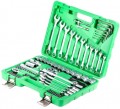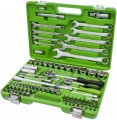Total number of items
The total number of core items included in the set.
In this case, the main items are all devices that are directly used during work: non-separable tools (traditional wrenches, hammers, pliers ...), elements of collapsible tools (for example, a ratchet for removable heads and 5 such heads will be considered 6 units) , as well as accessories (such as extensions or universal joints). Additional accessories — such as lights — may or may not be included in this count, depending on the manufacturer; however, there are usually few such accessories, and they do not fundamentally affect the total number of items.
The most modest modern tool kits include
up to 25 units. However, such kits are very popular — they are inexpensive and at the same time can be very versatile.
25 – 50 items is still quite a small number,
50 – 75 pcs can be called an average,
76 – 100 items are more than average, and the most extensive modern sets can include
100 – 150 items or even
more.
The general rules for choosing this parameter are obvious: a more extensive set, usually, is more multifunctional, but more expensive, weighs more and takes up more space. It is also worth bearing in mind that with a similar number of items, the specific assortment of these items in differ
...ent sets may be different; so when choosing, it is worth specifying not only the number of tools, but also their specific composition.Socket heads (6 points)
Number of
hex sockets included in the tool kit.
All end heads are accessories for a collapsible tool; during operation, they are mounted on a ratchet, wrench or other similar device. The head itself has the appearance of a characteristic “cap”, which, during operation, is put on a bolt, nut, etc. This design, among other things, allows you to work with parts located in recesses and some other hard-to-reach places that cannot be reached with open-ended, captive or split keys. And compared to a set of classic socket wrenches, the holder plus socket set takes up much less space, providing almost the same functionality.
As for the 6 faces, this type of socket head is the most famous and widespread, because. most modern nuts and bolts have this shape.
Spark plug sockets
The number of
spark plug heads supplied with the tool kit.
Like all interchangeable heads, candlesticks are put on the appropriate device during operation — for example, a ratchet (see above) or a tap wrench (see below). The specifics of their use is reflected in the name: the main purpose of this type of nozzle is the installation and dismantling of spark plugs in automobile engines. By design, spark plug sockets are generally similar to end heads, but they are much longer — otherwise working with candles would be impossible.
There is no single standard for fastening modern spark plugs, so several spark plug heads can be supplied in a set. At the same time, note that with the same number of such accessories, their specific types in different sets may be different; this nuance needs to be clarified before buying.
Bits
The number of
bits supplied with the tool kit.
A bat in this case is called a working nozzle, which plays the role of a screwdriver tip; in fact, they are most often used with screwdriver handles (see above).
Many types of splines (slots) are used in modern fasteners — starting with the well-known
straight, cross-shaped (
Phillips and
Pozidriv),
Torx sprockets and ending with exotics like Torq-set (a cross with lines shifted from the centre), Pentalobe (with five ledges), etc. .P. In addition, the size of the slots can also vary, and in many cases, tool matching in size is very important. Accordingly, the more bits supplied with the set, the more versatile it is, the higher the probability that it will contain a nozzle of the desired type and size. However, the specific list of bits in the kit also does not hurt to clarify — in order to make sure that it has all the varieties you need. In the characteristics of individual sets, these data are given in the paragraph "Bit sizes" (see below).
Adapter
An adapter for docking seemingly incompatible elements from a set. For example, socket heads with an unsuitable landing square on a ratchet, screwdriver handle or in a drill driver.
The adapter provides full-fledged work with all the required list of tools from the set.
Screwdriver handle
Number of
screwdriver handles supplied with the tool kit.
Such handles, in fact, are screwdrivers without a tip — in its place there is a seat for a bit. It can be either a square (see above) or a hexagon socket, often magnetic; in fact, the presence of more than one handle in the kit is typical mainly for cases where different types of fasteners are used. Also note that, in addition to fixed mounts, in which the bit is fixed rigidly, there are also reversible devices — with a ratchet mechanism, similar in operation to ratchets (see above).
Theoretically, bits can be used with other types of tools — for example, the ratchets described above — and in many sets this possibility is directly provided. At the same time, it is work in the format of a screwdriver that is considered the classic option, and often it is he who is optimal.
Extension
The type of extension included with the tool kit.
Extensions refer to "intermediate" devices, if necessary, installed between the main tool (like a screwdriver handle, see above) and the working nozzle. As the name implies, they allow you to increase the length of the working part of the tool — for example, to get to hard-to-reach places. Here are the main options for such devices:
—
Hard. Rigid rod extension. It does not give such freedom of action and the ability to get to hard-to-reach places as flexible (see below), but it is considered more reliable, allows you to develop great efforts (often the same as when working without an extension cord) and even allows the use as an improvised lever. Some rigid extensions may also have a crank function (see above).
—
Flexible. An extension in the form of a flexible tube, usually made of a metal spiral. Such an extension, like a universal joint (see above), allows you to position the nozzle at an angle to the axis of rotation of the main tool — while the range of such angles is much wider (in some cases they can reach 180 °), and the long length and high mobility of the device are even more expands freedom of action. The disadvantage of flexible extensions is less suitability for work with greater efforts than the rigid ones described above.
— Rigid/flexible. This option is indicated for sets equipped with both types of
...extensions described above. This makes it possible to choose an option depending on the specific situation.
If there are several extensions of the same type in the kit, they, usually, differ in the size of the attachment (see "Landing square").Combination wrenches
Number of
combination wrenches supplied with the kit. Note that some modern kits include
only combination wrenches, without any other fixtures or accessories.
Combined are called bilateral keys, on which different types of working profiles are located on different sides. Most often, such keys combine open-end and cap profile, very rarely — open-end and end. The technical features of each of these types are described in the corresponding entries in the glossary. However, anyway, the working dimensions of the profiles in one tool, usually, are the same — this allows, without changing the key, to choose the best option for a specific part, depending on the features of the work. As for the quantity, it is worth considering here: sets with the same number of keys of the same type may differ in the specific sizes of these tools. Such nuances should be clarified before buying separately.
Socket wrenches
Number of
socket wrenches supplied in the kit. Note that some modern kits
only include socket wrenches, without any other fixtures or accessories.
The working part of such a tool looks like a characteristic “cap” at the end of the handle (hence the name). This shape allows you to easily work in some hard-to-reach places where it is impossible to reach other types of wrenches — for example, recesses. But the general design of modern socket wrenches can be different. One of the most common options is an L-shaped handle with two "caps" of the same size, at both ends. When using a working profile on the short side of such a tool, the rest of the structure forms a long lever, allowing you to develop a fairly significant force; and the presence of a “cap” on the long side makes it possible to reach parts located in recesses of great depth and other similar places. Another design option is a wrench with a universal joint (see below); in such models, on different sides of the handle there are working profiles of different sizes. There is also a more specific version — a hollow tube with "caps" on both ends (also having different sizes) and a through transverse hole for a rod that plays the role of a rotary knob.
Separately, we note that socket wrenches are especially popular in car maintenance, although their use is not limited to this.

